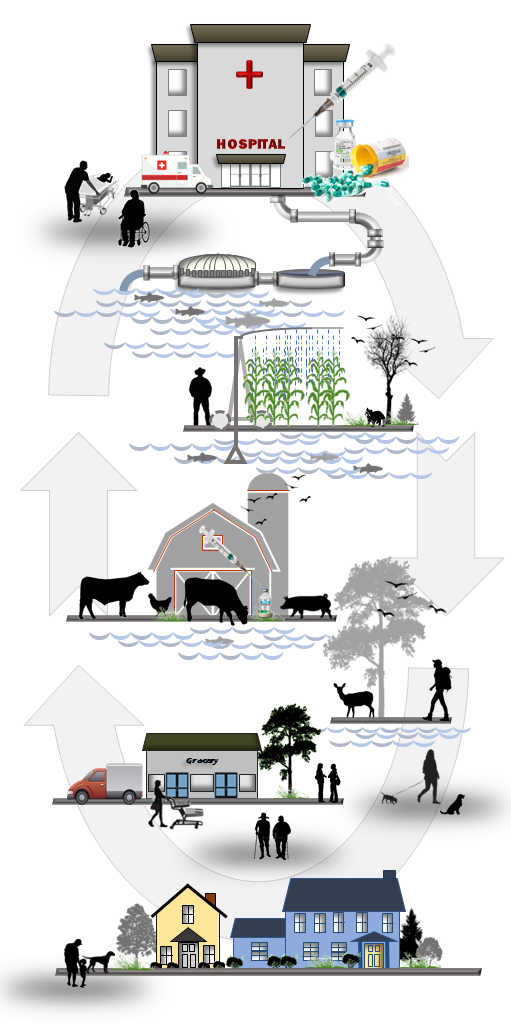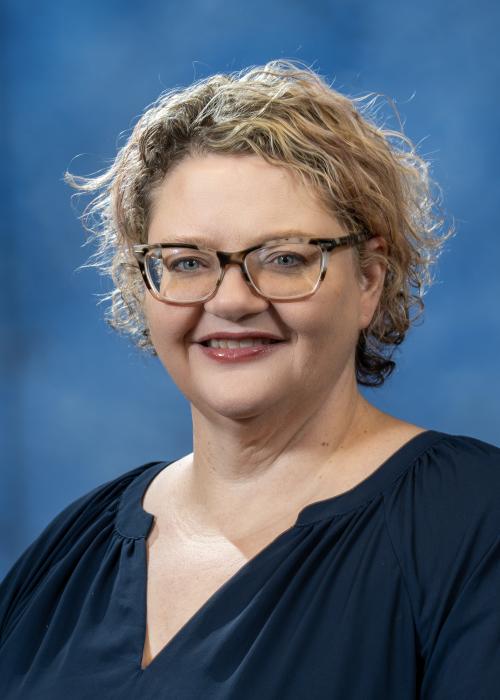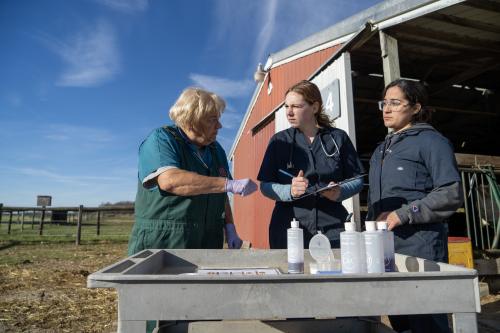VPM Voice: Summer 2025
Originally Published
Chair’s Message
It’s my pleasure to share the inaugural issue of VPM Voice with you. One of my priorities as chair of the Department of Veterinary Preventive Medicine (VPM) is to strengthen existing relationships and build new ones between VPM and our alumni, practicing food animal and public health veterinarians in Ohio, and our stakeholders.
Each quarter, this e-newsletter will bring you updates from VPM that highlight the research, teaching, and outreach performed by our faculty, staff, and students. We especially want to highlight how VPM is collaborating with stakeholders in these areas and explore new opportunities to expand our joint efforts to ensure animal and public health at the population level.
I hope you enjoy this information, and I welcome your feedback about this issue. I look forward to continuing to connect with you over the coming quarters.
Warm regards,
Alecia
Alecia Naugle, DVM, PhD
Professor and Chair
Department of Veterinary Preventive Medicine
College of Veterinary Medicine
Office: 614-247-0219
naugle.5@osu.edu
Enhancing the VPM Rotation to Align with Curriculum Transformation
As the College of Veterinary Medicine continues to enhance the pre-clinical curriculum to transform student learning, the Department of Veterinary Preventive Medicine has taken this opportunity to also revise the VPM Rotation for fourth year students.
About 70% of material previously taught during the rotation has been integrated earlier in the curriculum. Changes to the rotation allow students to recall and apply that knowledge in real world, hands-on situations. The rotation focuses on the maintenance of health and welfare in animals through a variety of measures, such as vaccination, parasite control, nutrition, and appropriate living conditions.
Students work with clients from the Large Animal Services at Marysville Clinic. They strengthen their problem investigation skills by investigating heard health issues and developing evidence-based solutions. In teams, students use peer reviewed literature to create solutions that address specific efficiency/productivity problems a farm may be facing. Students present their findings to farm owners and faculty and answer any additional questions that come up.
To gain experience in small animal preventive medicine, students spend time in shelters and with a surgery and outreach clinic. At the Franklin County Dog Shelter, students provide intake exams, while at Shelter Outreach Services of Ohio (SOS), they learn about shelter intake diversion. Students also gain lab animal medicine experience through a partnership with Nationwide Children’s Hospital Abigail Wexner Research Institute’s animal care program.
So far, student feedback has been positive. The department continues to evaluate and improve the rotation to meet educational goals and prepare students for diverse veterinary careers. They are already planning for exciting additions in the 2026 year, including a partnership with Columbus Humane Outreach.
Research in Action: One Health Approach Key to Tackling AMR
The discovery of antimicrobials revolutionized medicine and agriculture in the 20th century. However, this breakthrough was soon followed by the emergence of antimicrobial resistance (AMR), which renders these lifesaving drugs ineffective and poses a serious threat to human and animal health. Antimicrobials kill susceptible bacteria, allowing resistant strains to survive and multiply. This selection pressure occurs wherever antimicrobials are used, in homes, hospitals, veterinary clinics, and farms.
For many years, efforts to combat AMR focused on reducing antimicrobial use. Now, growing attention is being paid to the critical, and often under-recognized, role of the environment in the emergence and spread of resistance. Our laboratory investigates how resistant bacteria move through hospitals, farms, and natural ecosystems. In our recent publications in JAVMA and AJVR, we highlight how the environment contributes to AMR transmission.
Resistant bacteria, along with antimicrobial residues and resistance genes, are excreted in human and animal waste. Our research shows that while wastewater and manure treatment can reduce their levels, it does not eliminate them. Surveillance studies have found resistant bacteria, including those resistant to last-resort drugs like carbapenems, not only in healthcare settings but also in waterways, soils, farm environments, and wildlife. We also detected resistant bacteria in vegetables, animal-sourced food products, and animal feed.
Exposure to contaminated natural, farm, or healthcare environments can lead to colonization of humans and animals with resistant bacteria. These colonized individuals may then shed the organisms and resistance genes back into the environment, or unknowingly introduce them into human or veterinary healthcare settings, perpetuating the cycle.
Tackling AMR requires coordinated action across human health, veterinary medicine, agriculture, and environmental management. In addition to antimicrobial stewardship, we need a better understanding of the environmental drivers of resistance, stronger policies, and improved surveillance to reduce environmental contamination.
Our findings show that simply reducing antimicrobial use is not enough. The environment plays a critical role in the propagation and spread of AMR. By adopting a One Health approach, we can better understand and interrupt the cycle of AMR transmission and preserve the effectiveness of antimicrobials for future generations.
This article highlights recent research from the Department of Veterinary Preventive Medicine, including:
- Parker EM, Ballash GA, Mollenkopf DF, Wittum TE. A complex cyclical One Health pathway drives the emergence and dissemination of antimicrobial resistance. Am J Vet Res. 2024 Mar 9;85(4):ajvr.24.01.0014. doi: 10.2460/ajvr.24.01.0014. PMID: 38467112.
- Ballash GA, Parker EM, Mollenkopf DF, Wittum TE. The One Health dissemination of antimicrobial resistance occurs in both natural and clinical environments. J Am Vet Med Assoc. 2024 Mar 1;262(4):451-458. doi: 10.2460/javma.24.01.0056. PMID: 38428137.
By the Numbers
Swientist Program Expands Reach
Established 10 years ago to address a significant increase in swine flu infections among people attending county fairs, the Swientist® Program has expanded its reach to address new and growing threats, such as Highly Pathogenic Avian Influenza (HPAI). The program attends fairs and livestock shows and visits farm supply stores to provide engaging, hands-on biosecurity lessons for youth.

With additional funding from USDA NADPRP and CSTE, the program has added outreach to swine producers, backyard poultry producers and poultry exhibitors, equine producers, and youth beef producers. The Swientist® Program empowers young people to play an active role in biosecurity and builds a foundation for continuous learning and curiosity.
(numbers represent the 12 months prior)
12
States Visited
61
Presentations
9000+
Attendees
National Funding Fuels Ohio State’s Impact on Agricultural Health and Safety
The Department of Veterinary Preventive Medicine continues to demonstrate national leadership in agricultural research and disease preparedness, thanks in part to robust support from the National Animal Disease Preparedness and Response Program (NADPRP). Funded through the 2018 Farm Bill, NADPRP plays a vital role in protecting U.S. livestock by enhancing biosecurity, emergency response, and disease mitigation strategies.
For Ohio’s agricultural economy, this funding is more than just support; it’s a safeguard for the health of livestock and the stability of the food supply. Recent outbreaks of Highly Pathogenic Avian Influenza (HPAI) in poultry and dairy cattle, along with persistent threats like Porcine Reproductive and Respiratory Syndrome Virus and Salmonella Dublin, underscore the importance of proactive disease response. NADPRP funding allows faculty to work with producers to empower them to prepare for, and respond to, these challenges.
The department has secured multiple NADPRP grants, reflecting its strong reputation and impact. Faculty have cultivated close relationships with producers across the state, allowing them to identify critical gaps in biosecurity. For example, livestock markets create high-risk zones for disease spread as animal from various operations converge. Ohio State researchers will be working directly with these markets to implement best practices and improve biosecurity protocols.
For another project, the department is launching outreach initiatives aimed at small livestock farms, which often lack the resources or knowledge to establish effective biosecurity programs. These efforts will help prevent disease transmission and strengthen the resilience of Ohio’s agricultural communities.
“Our consistent success with NADPRP funding is a testament to the department’s ability to deliver meaningful, actionable results,” said [TBD?]. “We’re not just conducting research—we’re out in the field, working directly with producers and regulators to make a tangible difference.”
As external funding becomes increasingly vital, programs like NADPRP are essential. Without them, Ohio’s preparedness for future outbreaks would be significantly compromised, with potential consequences for both human and animal health, as well as the state’s economy.
The Department of Veterinary Preventive Medicine stands at the forefront of agricultural disease preparedness—leading with science, collaboration, and a commitment to protecting Ohio’s farms and food systems.


